1998 CHEVROLET VENTURE fuel pressure
[x] Cancel search: fuel pressurePage 13 of 474
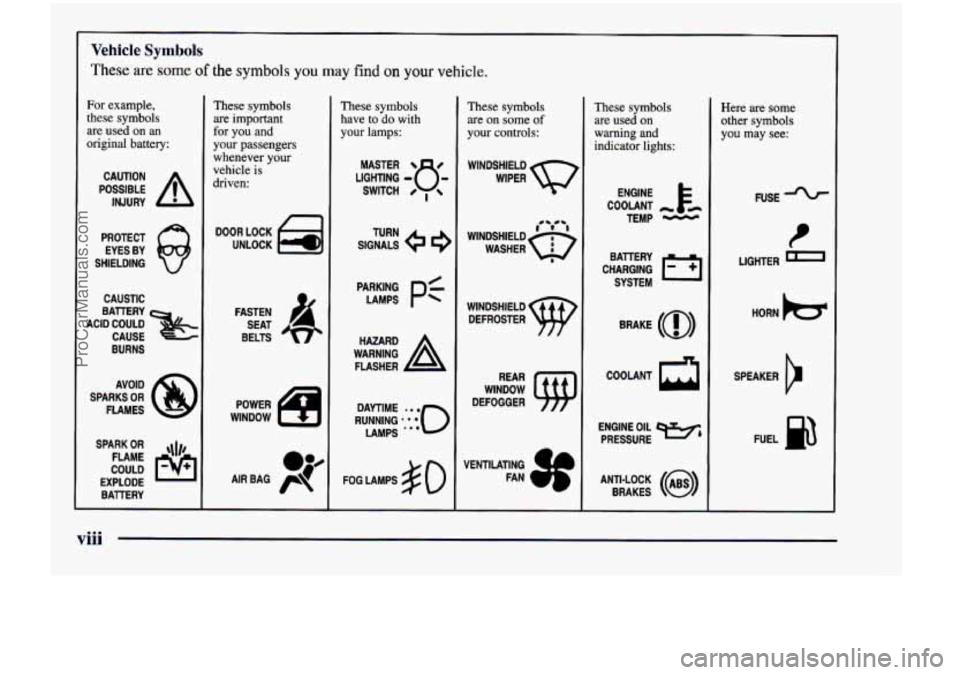
Vehicle Symbols
These are some of the symbols you may find on your vehicle.
For example,
these symbols
are used on an
original battery:
POSSIBLE A
CAUTION
INJURY
PROTECT EYES BY
SHIELDING
Q
CAUSTIC
BURNS AVOID
SPARKS
OR
FLAMES
SPARK
OR ,\I/,
COULD FLAME
EXPLODE BA'ITERY
These symbols
are important
for you and
your passengers
whenever your
vehicle is
driven:
DOOR LOCK
UNLOCK
FASTEN SEAT
BELTS
POWER
WlNDOW
These symbols
have to do with
your lamps:
SIGNALS e
TURN
FOG LAMPS
& 0
These symbols
are on some of
your controls:
WINDSHIELD WIPER
WINDSHIELD DEFROSTER
WINDOW
DEFOGGER
VENTILATING FAN
These symbols
are used on
warning and
indicator lights:
COOLANT -
TEMP -
CHARGING I-1
BAllERY
SYSTEM
BRAKE
(0)
COOLANT
a
ENGINE OIL e,
PRESSURE
ANTI-LOCK
(@)
BRAKES
Here are some
other symbols
you may see:
FUSE
LIGHTER m
HORN b
SPEAKER
cr
FUEL B
viii
ProCarManuals.com
Page 212 of 474
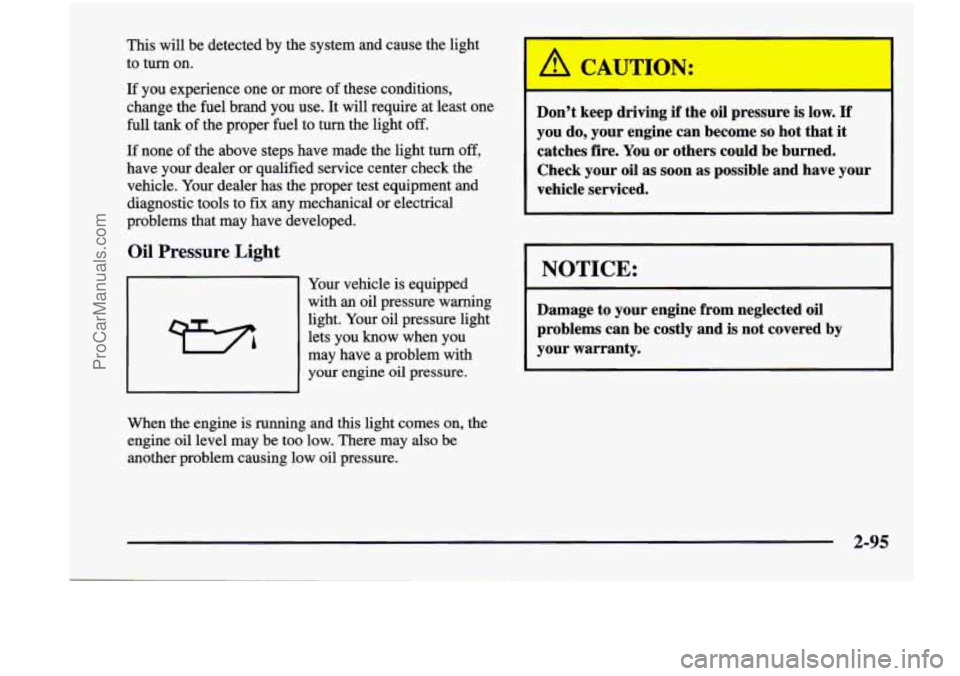
This will be detected by the system and cause the light
to turn on.
If you experience one or more of these conditions,
change the fuel brand you use. It
will require at least one
full tank of the proper fuel to turn the light off.
If none of the above steps have made the light turn off,
have your dealer or qualified service center check the
vehicle. Your dealer has the proper test equipment and
diagnostic tools to
fix any mechanical or electrical
problems that may have developed.
Oil Pressure Light
Your vehicle is equipped
with an oil pressure warning
light. Your oil pressure light
lets you know when you
may have a problem with
your engine
oil pressure.
When the engine is running and this light comes on, the
engine oil level may be too low. There may
also be
another problem causing low oil pressure. Don’t
keep driving if the
oil pressure is low. If
you do, your engine can become so hot that it
catches fire. You or others could be burned.
Check your
oil as soon as possible and have your
vehicle serviced.
NOTICE:
r
Damage to your engine from neglected oil
problems can be costly and
is not covered by
your warranty.
2-95
ProCarManuals.com
Page 276 of 474
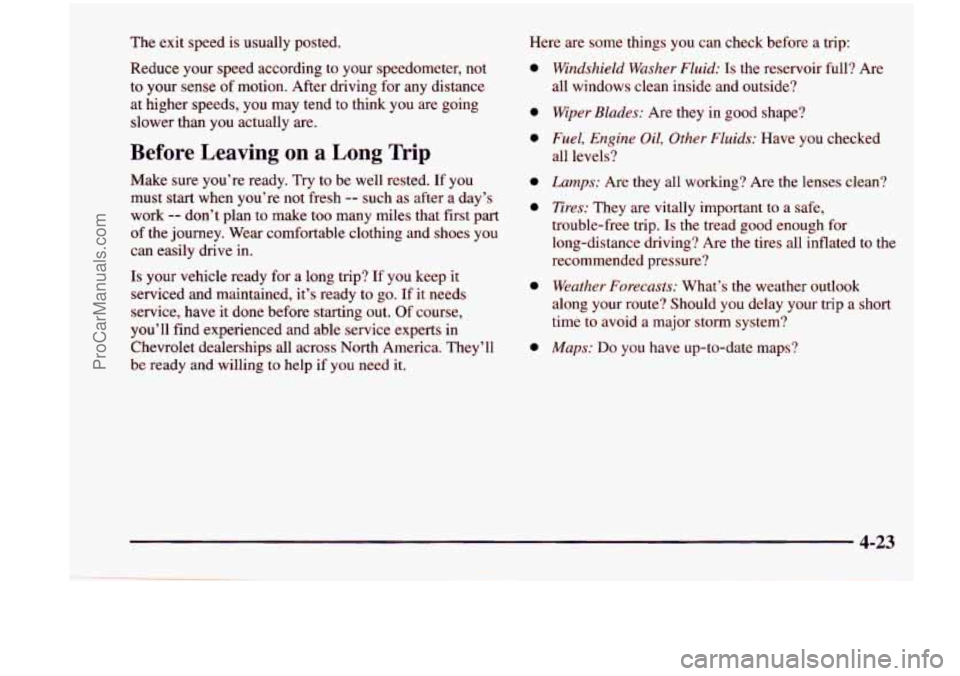
The exit speed is usually posted.
Reduce your speed according to your speedometer, not
to your sense of motion. After driving for any distance
at higher speeds, you may tend to think you
are going
slower than
you actually are.
Before Leaving on a Long Trip
Make sure you’re ready. Try to be well rested. If you
must
start when you’re not fresh -- such as after a day’s
work
-- don’t plan to make too many miles that first part
of the journey. Wear comfortable clothing and shoes you
can easily drive in.
Is your vehicle ready for a long trip? If you keep it
serviced and maintained, it’s ready to go.
If it needs
service, have
it done before starting out. Of course,
you’ll find experienced and able service experts in
Chevrolet dealerships all across North America. They’ll
be ready and willing to help if
you need it. Here
are some things you can check before a trip:
0
0
0
0
0
0
0
Windshield Washer Fluid: Is the reservoir full? Are
all windows clean inside and outside?
Wiper Blades: Are they in good shape?
Fuel, Engine Oil, Other Fluids: Have you checked
all levels?
Lamps: Are they all working? Are the lenses clean?
Tires: They are vitally important to a safe,
trouble-free trip. Is the tread good enough for
long-distance driving? Are the tires all inflated to the
recommended pressure?
Weather Forecasts: What’s the weather outlook
along your route? Should
you delay your trip a short
time to avoid a major storm system?
Maps: Do you have up-to-date maps?
4-23
ProCarManuals.com
Page 283 of 474
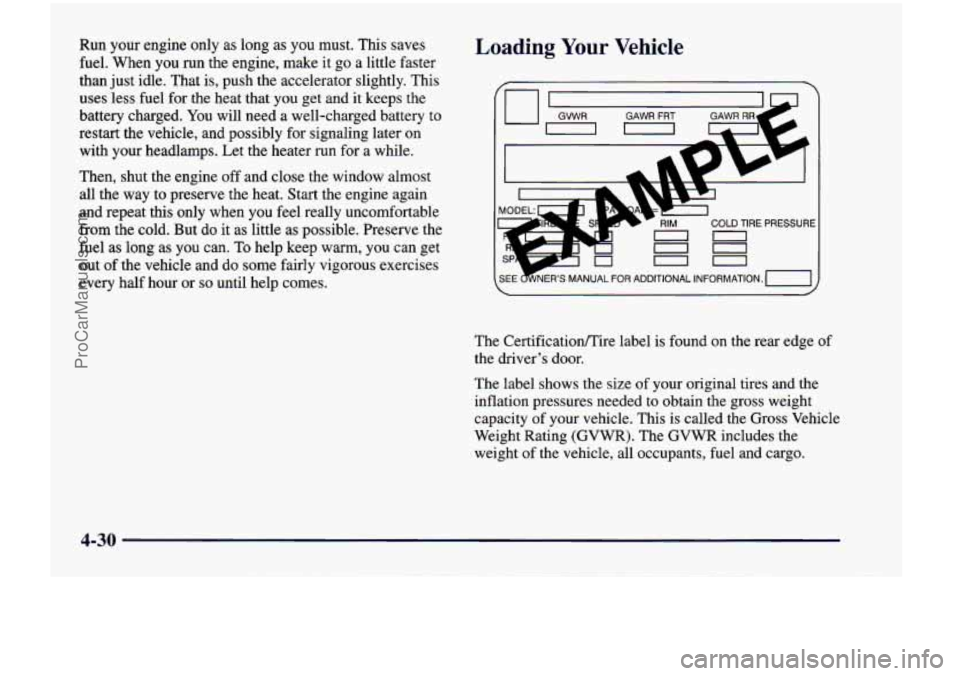
Run your engine only as long as you must. This saves
fuel. When you run the engine, make it go a little faster
than just idle. That is, push the accelerator slightly. This
uses less fuel for the heat that you get and
it keeps the
battery charged.
You will need a well-charged battery to
restart the vehicle, and possibly for signaling later on with your headlamps. Let the heater run for a while.
Then, shut the engine off and close the window almost
all the way to preserve the heat. Start the engine again
and repeat this only when you feel really uncomfortable
from the cold. But do it as little as possible. Preserve the
fuel as long
as you can. To help keep warm, you can get
out of the vehicle and do some fairly vigorous exercises
every half hour or so until help comes.
Loading Your Vehicle
COLD TIRE PRESSURE
00
00
on
The Certificationire label is found on the rear edge of
the driver’s door.
The label shows the size of your original tires and the
inflation pressures needed to obtain the gross weight
capacity of your vehicle. This
is called the Gross Vehicle
Weight Rating (GVWR). The GVWR includes the
weight of the vehicle, all occupants, fuel and cargo.
4-30
ProCarManuals.com
Page 336 of 474

Section 6 Service and Appearance Care
Here you will find information about the care of your vehicle. This section begins with service and fuel information,
and then it shows how to check important fluid and lubricant levels. There is also technical information about your
vehicle, and
a part devoted to its appearance care.
6- 18
6-2 1
6-24
6-25
6-26
6-30
6-3
1
6-39 6-2
Service
6-3 Fuel
6-7 Filling a Portable Fuel Container
6-
8 Checking Things Under the Hood
6-11 Engine Oil
6-15 Air Cleaner
6-16 Passenger Compartment Air Filter
Replacement
Automatic Transaxle Fluid
Engine Coolant
Radiator Pressure Cap
Windshield Washer Fluid
Brakes
Battery
Bulb Replacement
Windshield Wiper Blade Replacement 6-40
6-48
6-48
6-52
6-54
6-54
6-55
6-56
6-57
6-64
6-65
6-65
6-66
6-66
6-66 Tires
Appearance
Care
Cleaning the Inside of Your Vehicle
Cleaning the Outside of Your Vehicle
Underbody Maintenance Chemical Paint Spotting
Appearance Care Materials Chart
Vehicle Identification Number (VIN)
Electrical System
Replacement Bulbs
Capacities and Specifications
Engine Specifications
Vehicle Dimensions
Normal Maintenance Replacement Parts
Air Conditioning Refrigerants
ProCarManuals.com
Page 346 of 474
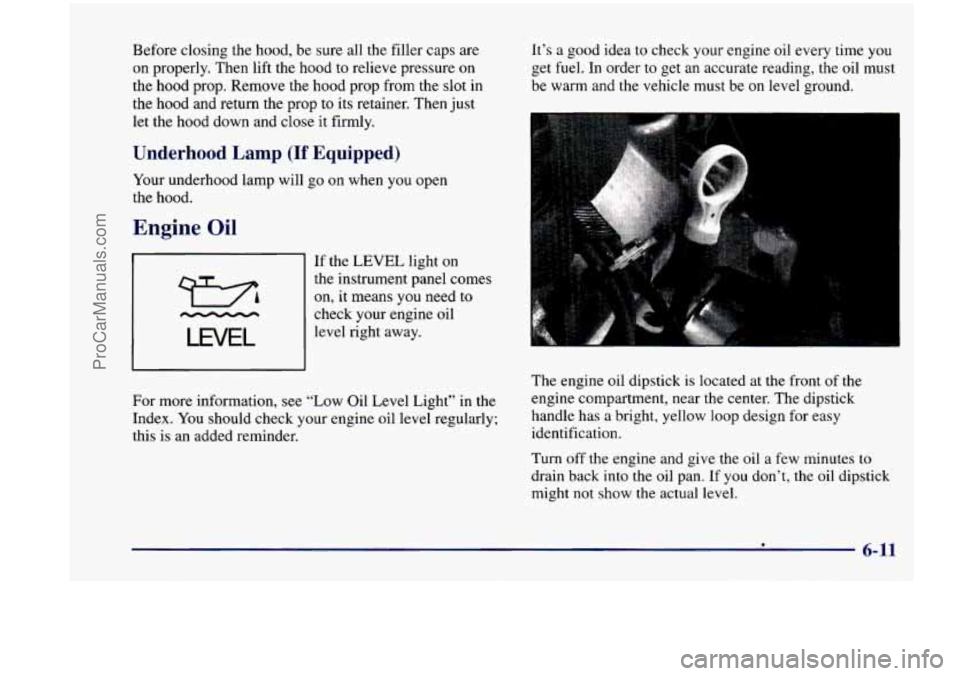
Before closing the hood, be sure all the filler caps are
on properly. Then lift the hood to relieve pressure on
the hood prop. Remove the hood prop from the slot in
the hood and return the prop
to its retainer. Then just
let the hood down and close it firmly.
Underhood Lamp (If Equipped)
Your underhood lamp will go on when you open
the hood.
Engine Oil
If the LEVEL light on
the instrument panel comes on, it means you need
to
level right away.
hhhhhh
LWEL
check your engine oil
For more information, see “LOW Oil Level Light” in the
Index. You should check your engine oil level regularly:
this
is an added reminder. It’s a good idea to check your engine oil every time
you
get
fuel. In order to get an accurate reading, the oil must
be warm and the vehicle must be on level ground.
The engine oil dipstick
is located at the front of the
engine compartment, near the center. The dipstick
handle has a bright, yellow loop design for easy
identification.
Turn off the engine and give the oil a few minutes
to
drain back into the oil pan. If you don’t, the oil dipstick
might not show
the actual level.
a 6-11
ProCarManuals.com
Page 376 of 474
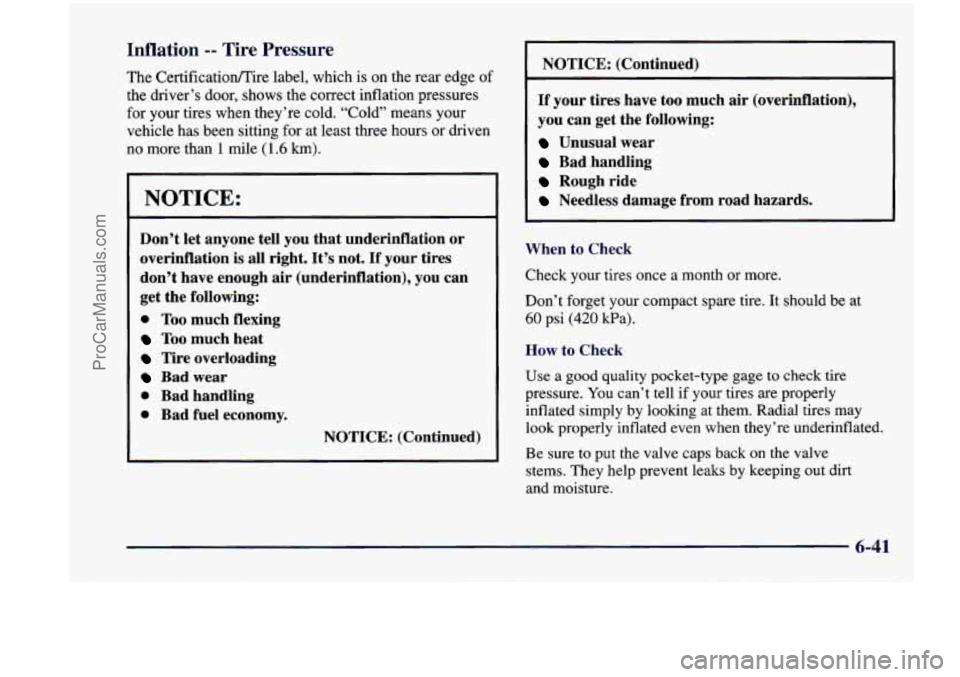
Inflation -- Tire Pressure
The Certificatioflire label, which is on the rear edge of
the driver’s door, shows the correct inflation pressures
for your tires when they’re cold. “Cold” means your
vehicle has been sitting for at least three hours or driven
no more than 1 mile (1.6 km).
NOTICE:
Don’t let anyone tell you that underinflation or
overinflation is all right. It’s not. If your tires
don’t have enough air (underinflation), you can
get the following:
0 Too much flexing
Too much heat
Tire overloading
Bad wear
0 Bad handling
0 Bad fuel economy.
NOTICE: (Continued) NOTICE: (Continued)
If your tires have too much
air (overinflation),
you can get the following:
Unusual wear
Bad handling
Rough ride
Needless damage from road hazards.
When to Check
Check your tires once a month or more.
Don’t forget your compact spare tire. It should be at
60 psi (420 kPa).
How to Check
Use
a good quality pocket-type gage to check tire
pressure. You can’t tell if your tires are properly
inflated simply by looking
at them. Radial tires may
look properly inflated even when they’re underinflated.
Be sure
to put the valve caps back on the valve
stems. They help prevent leaks by keeping out dirt
and moisture.
6-41
ProCarManuals.com
Page 400 of 474
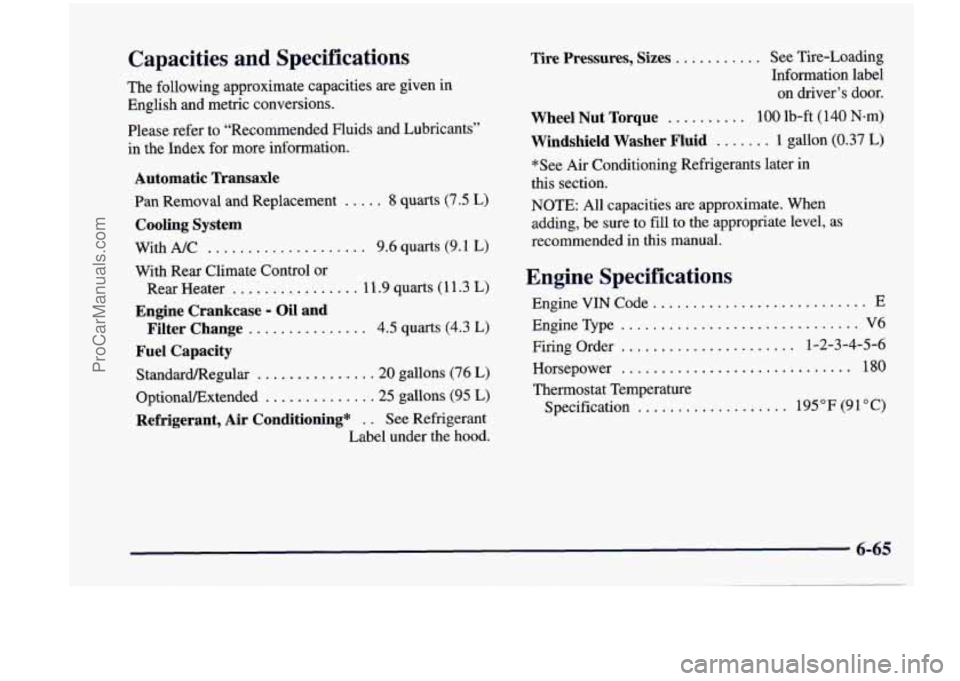
Capacities and Specifications
The following approximate capacities are given in
English and metric conversions.
Please refer to “Recommended Fluids and Lubricants”
in the Index for more information.
Automatic Transaxle
Pan Removal and Replacement ..... 8 quarts (7.5 L)
Cooling System
With A/C .................... 9.6 quarts (9.1 L)
With Rear Climate Control or
Engine Crankcase - Oil and
Fuel Capacity
Rear Heater ................ 11.9 quarts (11.3 L)
Filter Change ............... 4.5 quarts (4.3 L)
StandardRegular .............. .20 gallons (76 L)
OptionaVExtended ............. .25 gallons (95 L)
Refrigerant, Air Conditioning* . . See Refrigerant
Label under the hood.
Tire Pressures, Sizes ........... See Tire-Loading
Information label
on driver’s door.
Wheel Nut Torque .......... 100 lb-ft (140 N-m)
Windshield Washer Fluid ....... 1 gallon (0.37 L)
*See Air Conditioning Refrigerants later in
this section.
NOTE: All capacities are approximate. When
adding,
be sure to fill to the appropriate level, as
recommended in
this manual.
Engine Specifications
Engine VIN Code ........................... E
Firing Order ...................... 1-2-3-4-5-6
EngineType
.............................. V6
Horsepower ............................. 180
Thermostat
Temperature
Specification
................... 195 “F (91 “C)
6-65
ProCarManuals.com